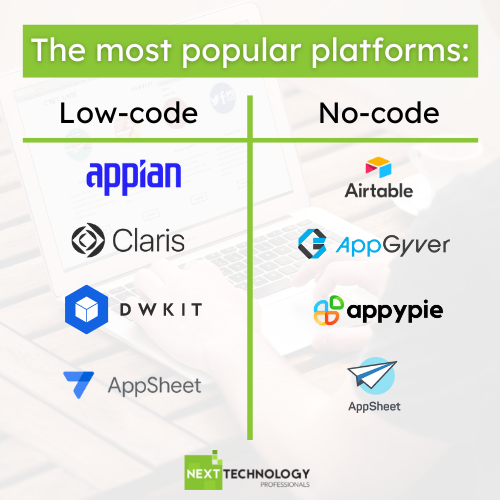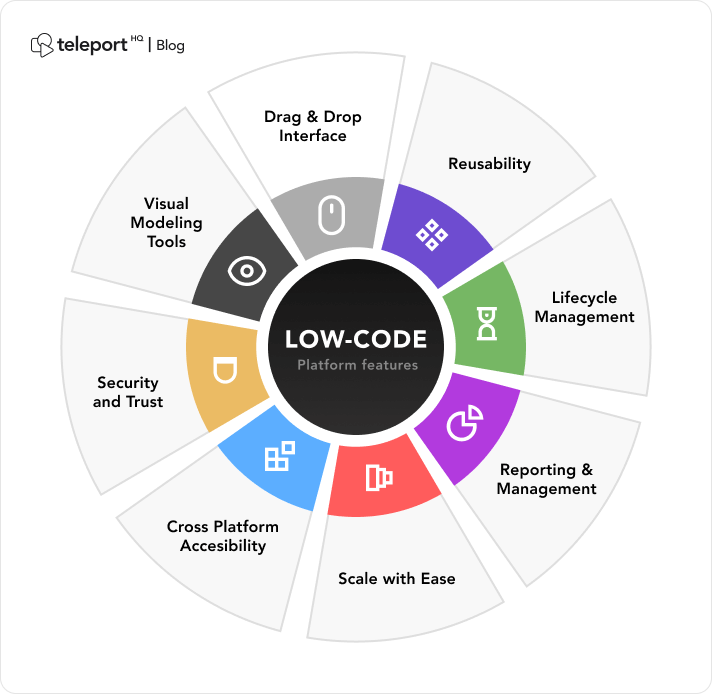Top Reasons For Selecting Low-code platforms for application development
Wiki Article
Benefits Of Low-Code Application Development In Terms Of Integration Capabilities
Low-code app development has many benefits, especially in terms integration. This is essential in creating apps that seamlessly connect to systems and other services. Here are a few of the main advantages: Prebuilt Connectors and APIs
A Variety of Connectors: Low-code platforms typically come with a vast library of prebuilt connectors to the most popular enterprise systems (e.g. ERP CRM, databases as well as cloud-based services). Integration of these systems is made easier.
API Integration: A lot of platforms have built-in API integration features. Developers can effortlessly connect with data from other sources and services.
Easy of use:
Drag-and Drop Integration: Many integration tasks can be accomplished using drag-and drop interfaces. This lets developers and nondevelopers to create complicated integrations using little or no programming.
Visual Workflow Builders Visual tools to design workflows and data flows help in understanding and setting up integrations with greater ease.
Standardized Integration Methods:
SOAP/RESTful Service Support: Standard web service protocols, such as SOAP/REST, allow for easy integration of a variety of external systems and applications.
OData Standards: OData standards permit the simple manipulation and accessibility of data across various platforms and applications.
Real-Time Data Synchronization:
Low-code platforms allow for real-time integrations between systems and applications. This allows data to be updated and consistent throughout the company.
Event-Driven Architectures: A few platforms offer event-driven architectures that enable applications to react in real-time when events occur, which is crucial for applications that are dynamic.
Legacy System Integration:
Low-code platforms are commonly utilized to integrate older systems. This enables organizations to modernize IT infrastructures without the need for a complete overhaul of existing systems.
Data Migration Tool: Built-in data migration tools permit data to be transferred from older systems into new applications which are built on low-code platforms.
Integration of Third-Party Services:
Cloud Services: Seamless Integration with Cloud Services such as AWS Azure Google Cloud and Google Cloud makes it easy to deploy applications.
Business Applications Low-code platforms allow you to connect with a variety of applications for business, such as Salesforce, SAP or Microsoft Dynamics. They allow a cohesive workflow for different business functions.
Simple Data Management:
Unified Data Models: Some low-code platforms provide unified data models which makes data integration easier and management across various systems.
Data Connectors are pre-configured data connectors which provide easy access to sources of data, and allow manipulation.
Security and compliance:
Low-code integration platforms adhere to security standards that protect data while in transit or in storage.
Security Features: These platforms often include features to ensure that integrations meet regulations (e.g. GDPR, HIPAA), providing assurance for companies handling sensitive data.
Extensibility:
Low-code platforms are able to accommodate complex integration needs by including custom scripts or code. They provide flexibility, without compromising their user-friendliness.
Plug-in Ecosystem: An ecosystem of plugins and extensions that can further extend the integration capabilities, allowing users to add new functionalities as needed.
Overall, the low-code platform's integration capabilities make it a powerful instrument for developing interconnected apps that are scalable and efficient. They make it easier to connect different platforms. They also enhance the flow of data. See the best helpful hints for Low-code Platform for application development for more advice including build a docker container, database in azure, rapid application design, low code platforms, develop web app, developing mobile apps, app modernisation, ms azure sql, build with docker, app development platform and more.

Cost-Effectiveness Is Among The Many Benefits Of Creating Applications That Use Low-Code.
The low-code approach to application development is an affordable solution with many benefits. It's an excellent choice for companies who want to make the most of their budgets and deliver top-quality applications. Here are the top benefits: Reduced Development Costs:
Lower Coding Requirements: Low coding platforms eliminate the need to write code manually which saves developers time as well as money. It also means lower labor cost.
A smaller number of developers: Since low code development is faster and simpler and less complex, there are fewer resources for developers required. Hiring and staffing costs can be drastically reduced.
Faster time to market:
Accelerated Development: Low-code platforms provide visual development tools, pre-built components and other features that enable rapid development of applications. Businesses can introduce their products to the market much faster. This can result faster revenue generation and better standing in the market.
Rapid Prototyping. By quickly creating and testing prototypes, companies can cut down on time spent developing and develop faster on user feedback.
Reduced Maintenance Costs
Simple Maintenance: Software developed using low-code platforms are generally simpler to maintain because of their standardized components and modular architecture. This can reduce the expense of ongoing maintenance and support.
Automated Updates Many low-code platforms can be adapted to managing updates and patches in a manner that's as secure as well as timely. This means there is no need to manually intervene.
Efficient Resource Utilization:
Low-code platform contributions let both business users and others who are not developers to take part in the creation process. This decentralization of development processes permits businesses to utilize the skills and expertise of a greater variety of employees.
Improved utilization of IT resources IT departments get the ability to focus on more strategic initiatives, instead of being bogged-down with simple development tasks. Overall productivity and efficiency improves.
Scalable pricing models:
Subscription pricing: Many low-code platform offer flexible subscription pricing models which increase with use. This allows companies to adjust their budgets according to their needs and growth without having to pay large upfront costs.
Pay-as-you-go: Certain platforms offer pay-as you-go options. This lets businesses only pay for the resources they actually need. This is especially useful for startups and small-sized businesses that have limited funds.
Reduce the costs of third-party software
Built-in Functionalities: Low-code platforms are equipped with a wide range of built-in functions and integrations, which eliminate the need for third-party software and tools. License and subscription costs are also cut down.
Pre-Built integrations: These pre-built systems and services are integrated with other popular services, which reduces the need for custom-developed software and saves both time and cost.
Increased ROI
Faster Return On Investment: The combination of speedy development and lower expenses with an increased time to market can help businesses get greater return on their investment.
Enhanced Agility: Businesses can rapidly adapt to market trends and customer needs and ensure that they remain relevant and can capitalize on new opportunities that arise.
Reduced Cost of Training
User-Friendly Interfaces: The user-friendly interfaces and user-friendly functions of low-code platforms help to reduce the learning curve thereby reducing the need to conduct lengthy training.
Accessible Resources Low-Code Platforms: Many low-code platforms have extensive training materials, tutorials as well as community support, cutting the requirement for formal education and associated cost.
Collaboration Streamlined:
Collaboration Tools: These tools aid in coordination and communication within teams, which results in improved processes for development and reduced cost of operations.
Unified Development Environment. An unified development platform helps reduce expenses and improve workflows by making it easier to manage several tools.
Overall, the cost effectiveness of low-code software development is due to its capability to lower maintenance and development costs and increase time to market, optimize resource use, and also provide flexible pricing models. These factors provide substantial financial rewards to businesses. Low-code is a great option for businesses that want to maximize budgets but still build robust, scalable, and high-quality software. Check out the recommended Legacy application modernization with Low-code advice for site examples including cloud software applications, build a docker container, application modernization, app development platform, app dev platform, driver jdbc, app dev platform, cloud software applications, push alerts, rapid application design and more.

Benefits Of Low-Code Application Development In Workflow And Collaboration
Low-code app development is an excellent choice for businesses who want to increase team efficiency by streamlining development processes. Here are a few of the benefits that are most notable: Improved cross-functional collaboration:
Unified Development Environment : Low-code platforms offer a unified, single environment where team members are able to work effectively such as business analysts, designers and other stakeholders. This reduces silos and promotes more effective communication.
Visual Development Tools - The drag-and drop visual nature of low-code platforms allows people who are not technical to easily participate in the development process. This ensures that the requirements of business are identified and accurately implemented.
Communication Enhancement
Real-Time Collaboration Many low-code applications include real-time features, such as editing and commenting simultaneously or instant feedback. This allows for continuous communication, which can reduce the amount of time spent on back-and-forth discussions.
Shared Workspaces : Teams can work in shared workspaces. They are able to view and edit the project components. This makes sure that everyone works towards the same goal.
Streamlined Workflow:
Built-in Project Management Tools: Low code platforms often include integrated project management software that aids teams organize, track, and manage, and coordinate their development projects. This includes tasks management, progress tracking and deadline management.
Workflow Automated: The automation of routine work, workflows, and other processes decreases the amount of manual work required and eliminates mistakes. This lets teams concentrate on more valuable tasks and increases efficiency.
Faster Iteration Cycles:
Rapid Prototyping Low-Code platforms are perfect for rapid prototyping. Iterative development is also feasible and allows teams to test, develop and refine their applications in shorter times. This lets feedback be swiftly implemented, and changes can be made.
Agile Development Support: Support for agile methodologies lets team members develop sprints. They are able to continuously provide tiny increments of functionality and easily adapt to changing requirements.
Accessibility for non-developers
Citizen Development: Low-code platforms empower business users (citizen developers) to design and develop applications without requiring a lot of coding experience. This frees IT and Development teams of burdens and gives them the ability to respond faster to the business demands.
Training and onboarding. Intuitive tools and extensive training resources help new team member get up-to-speed, improving the overall level of collaboration.
Centralized Documentation, Knowledge Sharing, and Information Sharing
Documentation is integrated into low code platforms usually come with tools to build and manage documentation within the platform, making it simple to allow all project data to be centralized.
Knowledge Repositories: Teams may create and maintain knowledge repositories that include best practices, templates, and reuseable components, helping to facilitate knowledge sharing and reducing duplicate work.
Consistency and uniformity:
Standardized Components. Utilizing pre-built standard components provides the sameness throughout all software. This helps team members learn and collaborate with various parts of projects.
Governance and compliance Frameworks for governance and compliance that integrate help ensure that development adheres to regulations and standards of the organization. This lowers the risk of noncompliance, and helps applications to meet the quality standards.
Feedback and Improvement Loops
Integrated Feedback Systems: Low code platforms offer integrated feedback systems that permit users to provide feedback about the application. Feedback can later be utilized in the creation of the applications.
Continuous Improvement: The ability to quickly iterate and implement changes based on feedback assures the continuous improvement of apps that are in line with the needs of users and business goals.
Visualization, Reporting and Analysis:
Real-Time Analyses: The built-in reports and analytics tools give instantaneous insight into the project's performance, development and user interactions, making it possible for data-driven decisions.
Visual Workflow Mapping - Visual tools that visualize workflows and processes can help teams optimize their workflows by identifying bottlenecks.
Low-code application development is a powerful tool for collaboration and workflow. It connects disparate teams, simplifies communication and streamlines processes. This creates a flexible, collaborative and efficient development environment that leads to more efficient and high-quality applications.
